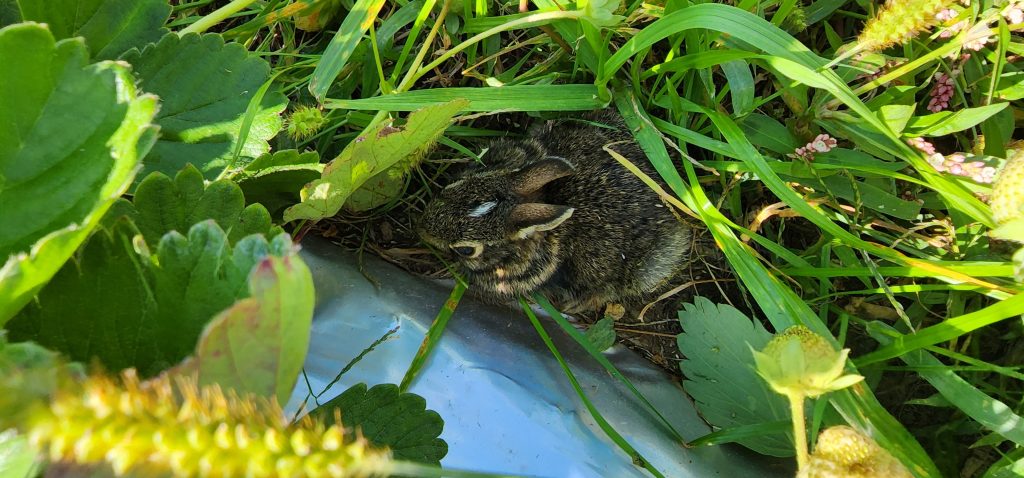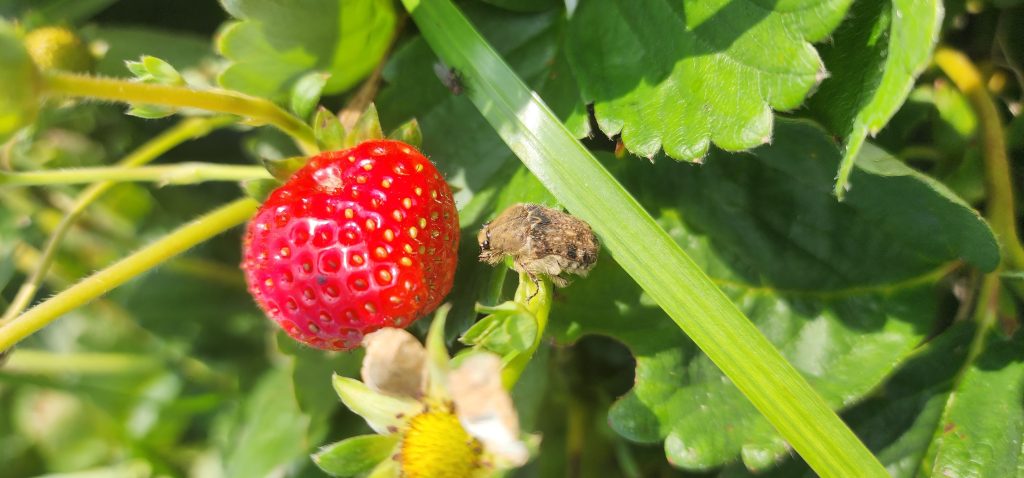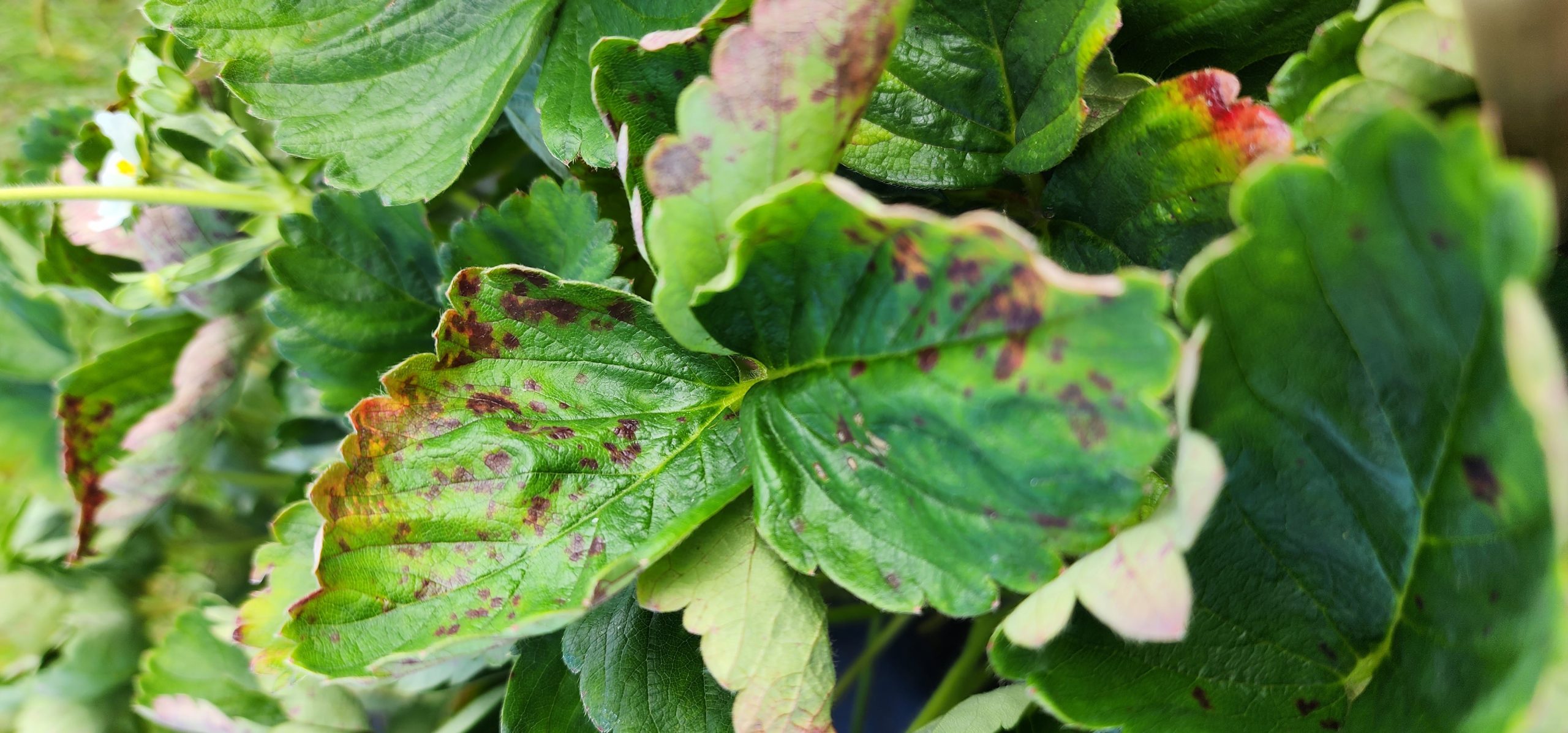Organic Day Neutral Strawberry Scouting Report for September 9, 2022
The scouting report for our day-neutral organic strawberry project at the West Madison Agricultural Research Station (WMARS) was done Friday September 9th in the afternoon.
Methods of sampling include randomly sampling 60 plants by tapping flower clusters and foliage over a wide funnel into plastic bags so that insects can be counted and identified. Each plant is inspected for disease symptoms and flower clusters are counted.
This past week, we continue to see social wasps, soldier beetles, spotted cucumber beetles, Japanese beetles, leaf/frog hoppers, tarnished plant bugs (Fig. 1), common leaf spot (Fig. 3), and Phomopsis leaf blight (Fig. 4). Field conditions during Friday’s collections were cooler with slight winds.
In recent weeks we have seen some minute pirate bugs (Orius spp) in our scouting. Orius bugs are beneficial insects in that both the immature (nymph) and adult stages are predatory on small insects, including many pest insects such as thrips, spider mites, aphids, small caterpillars, an different type of insect eggs. Orius grabs on to the prey with its front legs and inserts its mouthparts into the prey to suck on the juicy insides of the prey. It is thus important to reduce insecticide sprays to allow beneficial insects to establish in a planting.

Spotted-wing drosophila (SWD; Fig 1) are very small and invasive vinegar flies that lay eggs in ripe soft-skinned fruit. They are most effectively sampled using salt floats. We randomly select 10 berries weekly and place them in a plastic bag with a salt solution, crush the berries, and leave the berries to soak for an hour. The fruit is then filtered through a coffee filter and larvae are counted. This week’s sampling average increased to 0.23 larva per berry (Table 1.) There is no formal action threshold for SWD and once larvae are detected in fruit, it is recommended to spray an insecticide to prevent further infestation. While we have not sprayed for SWD at this time, we would recommend berry growers spray an insecticide once larvae are detected in fruit. Recommended insecticides for organic production include products such as Spinosad (Entrust), Pyganic (pyrethrins), and Grandevo (chromobacterium). For more information on managing SWD in organic production, refer to this comprehensive publication. As strawberry is not the most susceptible fruit, we recommend sampling fruit for the presence of larvae instead of using monitoring traps.
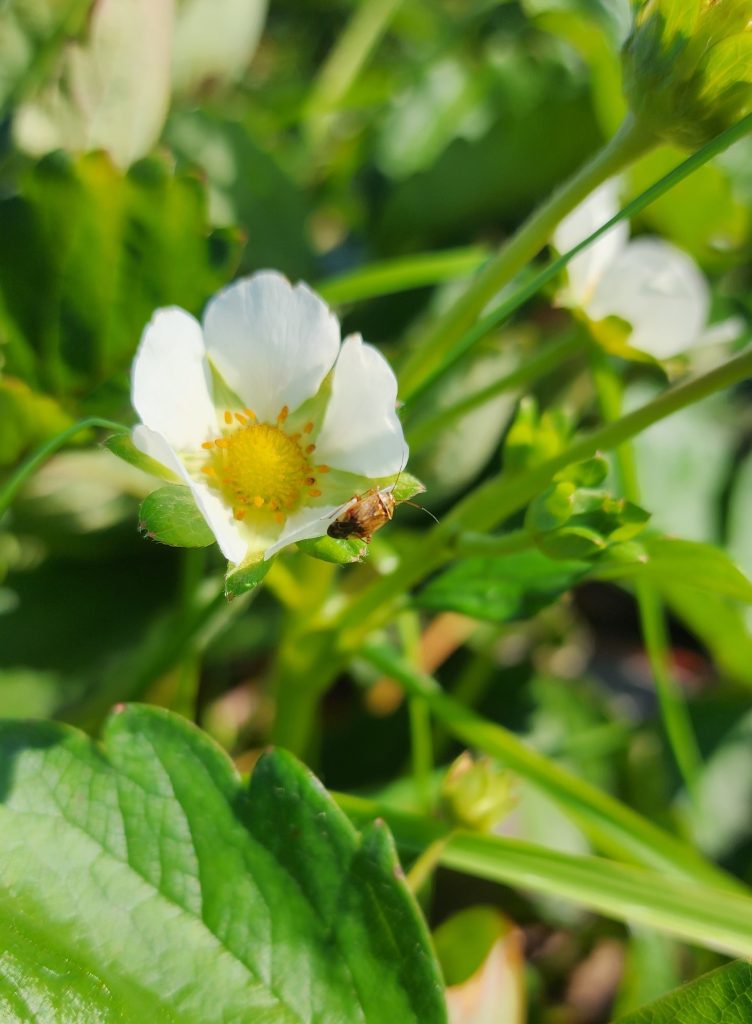
Tarnished plant bugs (TPB, Fig. 2) continue to decline (Table 1.) The economic threshold for TPB is one nymph per 4 flower clusters. Pyganic 1.4E was applied via backpack sprayer at a rate of 1.5 fl oz/ gallon (11.7ml/L) on 07/28/22, with no decrease in the population the following week (Table 1). The reason we did not see a decline is due to the design of our experiment: indeed we only sprayed half of our plot (the horticulture section) and not the scouting section to allow for the scouting of insects and disease to continue undisturbed. The horticulture section did see a decrease in TPB damage, characterized by catfacing symptoms following the application. Other organically-approved insecticides include Azadirachtin which has shown control in some studies for organic production.
Thrips numbers saw a sharp decline this past week and are well below the action threshold of 2-10 per flower or small berry (Table 1). Overall this season, thrips were present but did not seem to cause any significant fruit injury in the planting, thus no insecticide was applied to manage thrips.
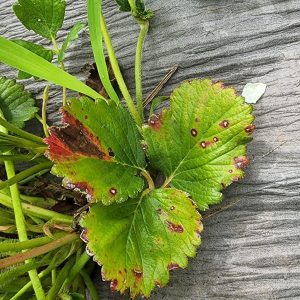
Common Leaf Spot (figure 3)saw an increase this week (Table 2). As of the latest field observations, leaf spots remain mild with only a few spots per plant. To read more about Common Leaf Spot and other foliar diseases of strawberry check out this article on “Fungal Foliar Diseases of Strawberry”
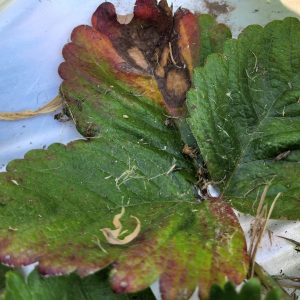
Phomopsis Leaf Blight (figure 4) numbers are consistent with the previous week (Table 2). This blight can lead to defoliation and fruit rot in later stages. Management techniques include removing infected leaves, weeding, and fungicide application. To read more about Leaf Blight and other foliar diseases of strawberry check out this article on “Fungal Foliar Diseases of Strawberry”
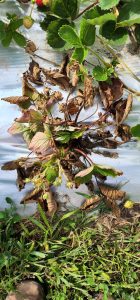
Symptoms such as dry, drooping leaves and collapsing plants have emerged in the field over the past two weeks (Fig. 5) and appear to be consistent with Verticillium Wilt. We have also observed slight discoloration in the crown tissues of some collapsed plants. This week’s sampled plants had far fewer signs than previous collections (table 2). Management practices are limited once plants are presenting symptoms and mortality. Avoid planting in contaminated soils and prevent any root damage to the remaining healthy plants to minimize its spread.
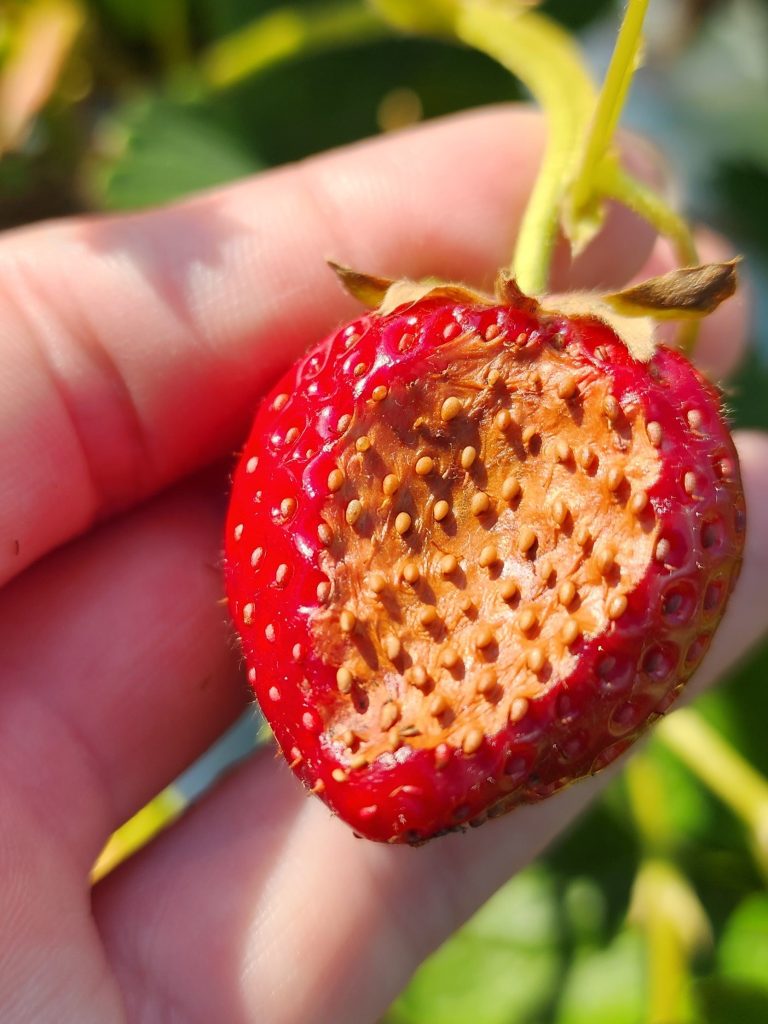
Anthracnose was present this week among two or three scouted plants. This disease presents as sunken lesions appearing tan to dark brown; under humid conditions orange masses of spores are visible in the lesions. Available organic fungicides for managing anthracnose are most effective when disease pressure is low. Additional management includes removing ripe and infected fruits regularly to slow its spread. To read more about Anthracnose and other fruit rots of strawberry check out this article on “Fruit Rots of Strawberry”
Table 1. The average number of insects observed per plant in day-neutral strawberries during weekly sampling.
| Dates of Weekly Scouting | Mites (Average per plant) | Thrips (Average per flower cluster) | Thrips (Average per plant) | Tarnished plant bug (Average per flower cluster) | Tarnished plant bug (Average per plant) | Spotted-wing drosophila (Average per berry) | Minute Pirate Bugs (Average per plant) |
| 6/15/2022 | 0.22 ± 0.11 | n/a | 0.16 ± 0.09 | n/a | 0 | n/a | n/a |
| 6/22/2022 | 0.01 ± 0.01 | n/a | 0.03 ± 0.03 | n/a | 0 | n/a | n/a |
| 6/28/2022 | 0.08 ± 0.04 | n/a | 0.05± 0.03 | n/a | 0 | n/a | n/a |
| 7/05/2022 | 0.13 ± 0.06 | n/a | 0.12 ± 0.05 | n/a | 0.03 ± 0.02 | n/a | n/a |
| 7/13/2022 | 1.28 ± 0.35 | n/a | 0.25 ± 0.07 | n/a | 0.08 ± 0.49 | n/a | n/a |
| 7/19/2022 | 4.30 ± 0.51 | n/a | 0.20 ± 0.06 | n/a | 0.33 ± 0.08 | n/a | n/a |
| 07/28/2022 | 3.37 ± 0.38 | n/a | 0.27 ± 0.07 | n/a | 1.32 ± 0.24 | n/a | n/a |
| 08/02/2022 | 3.62 ± 0.35 | n/a | 0.23 ± 0.06 | n/a | 1.87± 0.29 | n/a | n/a |
| 08/09/2022 | 2.27± 0.27 | 0.30 ± 0.04 | 0.35 ± 0.09 | 0.69± 0.12 | 2.48± 0.34 | 0 | n/a |
| 08/16/2022 | 0.68 ± 0.12 | 0.10 ± 0.03 | 0.25 ± 0.06 | 0.71 ± 0.11 | 1.55 ± 0.17 | 0 | n/a |
| 08/23/2022 | 0.63 ± 0.1 | 0.12 ± 0.04 | 0.18 ± 0.05 | 0.64 ± 0.14 | 1.03 ± 0.17 | 0 | 1.80 ± 0.23 |
| 08/27/2022 | 0.80 ± 0.15 | 0.13 ± 0.04 | 0.23 ± 0.06 | 0.56 ± 0.09 | 0.85 ± 0.11 | 0.04 ± 0.06 | 1.33 ± 0.2 |
| 09/02/2022 | 0.83 ± 0.12 | 0.21 ± 0.05 | 0.48 ± 0.10 | 0.41 ± 0.07 | 0.82 ± 0.13 | 0.10 ± 0.11 | 1.12 ± 0.15 |
| 09/09/2022 | 0.57± 0.11 | 0.06 ± 0.02 | 0.12 ± 0.04 | 0.3 ± 0.05 | 0.67 ± 0.1 | 0.23 ± 0.3 | 0.62 ± 0.12 |
Table 2. The average number of disease symptoms observed per plant in day-neutral strawberries during weekly sampling.
| Dates of Weekly Scouting | Common Leaf Spot (Average per plant) | Phomopsis Leaf Blight (Average per plant) | Verticillium Wilt (Average per plant) | Anthracnose (Average per plant) |
| 6/15/2022 | 0 | 0 | 0 | 0 |
| 6/22/2022 | 0 | 0 | 0 | 0 |
| 6/28/2022 | 0 | 0 | 0 | 0 |
| 7/05/2022 | 0 | 0 | 0 | 0 |
| 7/13/2022 | 0.35 ± 0.06 | 0 | 0 | 0 |
| 7/19/2022 | 0.57 ± 0.06 | 0.25 ± 0.06 | 0 | 0 |
| 07/28/2022 | 0.55± 0.06 | 0 | 0 | 0 |
| 08/02/2022 | 0.8 ± 0.05 | 0.22 ± 0.05 | 0 | 0 |
| 08/09/2022 | 0.87 ± 0.04 | 0.17 ± 0.05 | 0 | 0 |
| 08/16/2022 | 0.77 ± 0.06 | 0.38 ± 0.06 | 0 | 0 |
| 08/23/2022 | 0.82 ± 0.05 | 0.23 ± 0.06 | 0.03 ± 0.02 | 0 |
| 08/27/2022 | 0.88 ± 0.04 | 0.33 ± 0.06 | 0.02 ± 0.02 | 0 |
| 09/02/2022 | 0.68 ± 0.06 | 0.27 ± 0.06 | 0.07 ± 0.03 | 0 |
| 09/09/2022 | 0.72 ± 0.06 | 0.28 ± 0.06 | 0.02 ± 0.02 | 0.02 ± 0.02 |
Enjoy some fun and interesting pics (Figs 7, 8, and 9).
